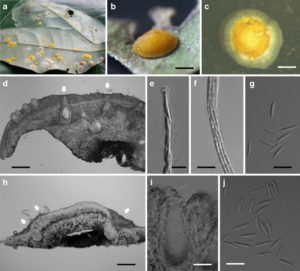Moelleriella phukhiaoensis Mongkol., Thanakitp. & Luangsa-ard, sp. nov., Index Fungorum number: IF 51609
Etymology: The specific epithet refers to Phu Khiao Wildlife Sanctuary, the collection location
Specimens were found on the underside of dicotyledonous leaves. Hosts are scale insect nymphs (Hemiptera). Stromata flattened pulvinate, sometimes surrounded by a membranous hypothallus; up to 5 mm diam. and 2 mm high, dark orange to golden yellow. Sexual morph Perithecia 400–520 × 150– 200 μm, crowded, immersed, elongate flask-shaped, ostioles slightly projecting, translucent. Asci 195–220 ×8–12μm, cylindrical, with cap approx. 4–6 thick. Ascospores disarticulating into 12.5–17.5 × 2–3 μm part-spores inside the ascus, cylindrical with somewhat rounded ends. Asexual morph Conidiomata orifice scattered or circularly arranged, ultimately hidden by the orange-yellow mass or extruded conidia, oval or elongate flask shaped, up to 430 μm deep, up to 100 diam. Conidiogenous cells cylindrical, up to 25 μm long, 1–2 μm wide. Conidia 16–17 μm × 2.5–3.5 μm, cylindrical narrow, tapering slightly towards the ends. Paraphyses present, linear, filiform, up to 90μm long; 1–2μm wide.
Culture characteristics: Cultures were obtained from germinating ascospores and conidia. The ascospores and conidia germinated within 48 h on PDA. The colonies on PDA grew slowly, to approx. 5 mm diam. after 4 weeks at 20 °C. The stromatic colonies derived from germinating ascospores or conidia formed a compact mycelium. The conidial mass yellow to orange yellow appearing as abundant slimy masses scattered over the surface of stromatic colonies.
Material examined: THAILAND, Chaiyaphum Province, Bueng Pan Protect Forest Unit, Phu KhiaoWildlife Sanctuary, 15 October 2005, S. Mongkolsamrit, R. Ridkaew, B. Thongnuch, K. Tasanathai (BBH 17305, holotype); ex-type living culture, BCC19769.
Notes: The sexual morph of M. phukhiaoensis is rarely found when compared with the asexual morph. The asexual
morph of M. phukhiaoensis was compared with the Thai material of Aschersonia placenta (sexual morph M. raciborskii) based on the pale yellow to light orange stromata. Although the asexual morph of M. phukhiaoensis morphologically resembles A. placenta, it differs significantly from the latter in having longer conidia (12–14× 2–2.5μm) as reported for A. placenta by Luangsa-ard et al. (2007). Moelleriella phukhiaoensis has only been collected in the Phukhiao Phu Khiao Wildlife Sanctuary.
Fig. Moelleriella phukhiaoensis (holotype) a, b Fungi on hosts c Culture derived from ascospores on PDA (sporulation present) d Side view of ascostroma showing flask-shaped perithecia (arrows) e Ascus showing a thickened cap f Part of ascus showing ascospores g Ascospores h Longitudinal section through the stroma showing conidiomata with conidia (arrows) i Conidiogenous cells and paraphysis j Conidia. Scale bars: b, c = 1 mm; d = 500 μm; e, f=10μm, g, j =20μm, h, i = 100 μm.

